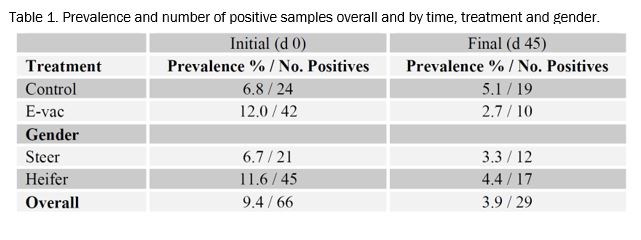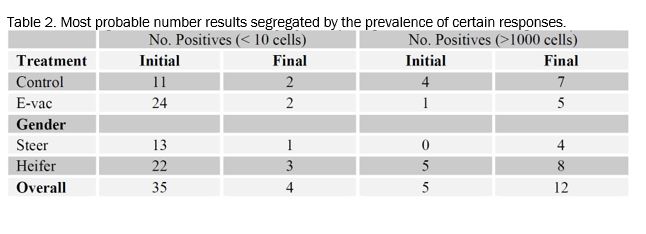Project Summary
Vaccination as an Intervention Strategy for the Reduction of Escherichia coli O157:H7
- Principle Investigator(s):
- John Paterson1, Gary Smith2, and Keith Belk2
- Institution(s):
- 1Montana State University
- 2Colorado State University
- Completion Date:
- May 2004
Background
Significant progress has been made in reducing the incidence of E. coli O157:H7 in the harvest sector. The development of multiple hurdle intervention systems and the implementation of Hazard Analysis Critical Control Points (HACCP) based inspection systems have all contributed to the reduction of this deadly pathogen. While that progress is encouraging, concerns have arisen that with the highly prevalent nature of E. coli O157:H7 in the production sector, measures should be investigated that attempt to prevent or minimize the risk that slaughter cattle would carry foodborne pathogens into harvest facilities. As a result, researchers are focusing efforts on intervention methods that can be applied to live animals to reduce or potentially eliminate E. coli O157:H7 prior to cattle ever entering a slaughter facility.
The objectives of this project were twofold:
- Determine the baseline prevalence for the proportion of freshly weaned calves shedding Escherichia coli O157:H7; and
- Determine the effectiveness of an experimental vaccine as a pre-harvest intervention strategy for reducing the proportion of calves shedding E. coli O157:H7 in the feces.
Methodology
More than 750 weaned calves (389 heifers and 367 steers) were sourced from a spring-calving herd in central Montana. Calves were randomly assigned to an experimental treatment group and were given an experimental Escherichia coli vaccination (E-vac) designed to prevent the attachment of E. coli O157:H7 to the intestinal wall of cattle. The calves were measured for initial weight (d 0), final weight (d 45), average daily weight gain, blood antibody titers (d 0, 21 and 45) and fecal prevalence of E. coli 0157:H7 (d 0 and d 45).
Findings
Irrespective of treatment, 9.4% of the animals were shedding E. coli O157:H7 at time of weaning and 3.9% were positive following the preconditioning period. Despite randomization, the initial prevalence in control calves was lower than the initial prevalence in calves that were to be vaccinated (6.8% versus 12%). Following the 45-day preconditioning period, the prevalence of the pathogen in vaccinated calves was lower than that in the control calves (2.7% versus 5.1%). There were also differences between the genders. The heifers had higher initial prevalence rates than steers.
According to the researchers, it is important to understand the meaning of the prevalence data. The basis for the vaccine as a preharvest intervention is to prevent the colonization of E. coli O157:H7 on the intestinal wall of cattle. It is arguable as to whether or not shedding of the pathogen is even relevant. For example, the absolute presence or absence of the pathogen in the feces on any given day can not determine the difference between an animal that is continuously shedding a colonized pathogen and one that recently picked up the pathogen from its contaminated surroundings and is shedding it in a transient manner. This problem with prevalence data in evaluating the effectiveness of the vaccine is also the rationale for supporting the most probable number (MPN) method as a way to estimate the amount of O157:H7 being shed. By having an estimate of cells per gram, researchers can distinguish between a colonized and a transient shedder by making a few assumptions.
The most probable number summary provides a method to distinguish between animals shedding greater than 10 cells per gram of feces and those that are shedding less than 10 cells per gram, as well as the potential to distinguish between animals that may be colonized from those that are not.
Overall, there were approximately half (35) of the initial positive samples (66) that had less than 10 cells per gram and there were only four of 29 positive samples with less than 10 cells per gram following the 45-day preconditioning period. Initial rates of animals shedding an infective dose remained relatively constant over the 45-day period.
The researchers made the assumption that if animals were shedding 1,000 cells per gram or more, then they were colonized with E. coli O157:H7. The data in the following tables show an increase in the number of colonized animals in both the control and vaccinated groups indicating no reduction in the number of colonized animals by vaccinating them against E. coli O157:H7. The same is true for the most probable number values, as there were no differences in the initial values versus the final values for the controls and experimentally vaccinated animals respectively.
Implications
The low prevalence of E. coli observed in this experiment limits the analysis and makes it difficult to assess the effectiveness of the Escherichia coli vaccine. The researchers suggested that future comparisons be conducted using animals inoculated with E. coli O157:H7 to prevent the difficulties associated with low prevalence. The researchers did feel however, that the baseline prevalence of 9.4% among the weaned calves was enough to perpetuate infection and should be considered a problem worth addressing with intervention methods.

